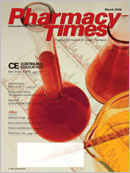Publication
Article
Pharmacy Times
Acute Disseminated Candidiasis
Author(s):
Acute disseminated candidiasis, or invasive candidiasis, is a fungal infection of Candida spp. It usually presents as candidemia and progresses to several viscera (ie, liver, kidney, spleen, eyes, brain, and heart). Candida spp are among the most common causes of nosocomial bloodstream infections typically introduced from the gastrointestinal tract or from venous catheters.1 Clinical manifestations of candidiasis can be nonspecific but may include unresolved fever and may progress to sepsis. Definitive diagnosis requires histopathologic confirmation, but presumptive diagnosis is used frequently in high-risk immunosuppressed or neutropenic patients. Pharmacologic intervention is required with a confirmed positive culture, and catheter removal is recommended for suspected infections.2
The most common pathogen for invasive candidiasis is C albicans (41%-65%); however, non-albicans Candida spp resistant to conventional treatments have emerged as prevalent causes of candidiasis, including C parapsilosis (15%- 24%) and C glabrata (10%-15%).3,4 In addition, C glabrata and C krusei have demonstrated decreased susceptibility to fluconazole and require higher therapeutic doses of amphotericin B (1 mg/kg/day).
Presumed diagnosis of candidiasis often results in empiric therapy in the critically ill. Based on FDA indications and the Infectious Diseases Society of America recommendations, traditional amphotericin B deoxycholate (AmBd) has been and remains a first-line empiric therapy option. Unfortunately, AmBd is associated with an increase in mortality induced by nephrotoxicity. Therefore, the use of lipid-based amphotericin (ie, amphotericin B lipid complex and liposomal amphotericin B) should be considered for individuals at high risk of developing AmBd intolerance.5
Alternatively, caspofungin (Cancidas; an echinocandin) is an FDA-approved agent recommended for the treatment of adults with invasive candidiasis. The novel use of a combination of AmBd plus caspofungin has shown no antagonism and enhanced efficacy against Candida spp.6 Fluconazole also is a treatment alternative for susceptible species. A combination of high doses of fluconazole and AmBd for 5 to 6 days has documented effectiveness as empiric candidiasis therapy.
Switching to oral fluconazole should be considered as step-down therapy in a stable patient after completion of therapy with intravenous agents.2
Dr. Riche is the Mercy Family Medicine specialty resident at the St. Louis College of Pharmacy.
For a list of references, send a stamped, self-addressed envelope to: References Department, Attn. A. Stahl, Pharmacy Times, 241 Forsgate Drive, Jamesburg, NJ 08831; or send an e-mail request to: astahl@ascendmedia.com.







